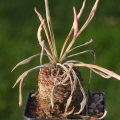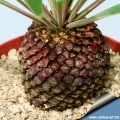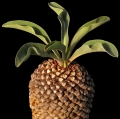
Euphorbia bupleurifolia Photo by: Valentino Vallicelli
This lovely popular dwarf succulent looks a bit little an itty-bitty cycad, except for its simple lancelote leaves. Very different and interesting.
Origin and Habitat: South Africa, widespread in the Eastern Cape Province and KwaZulu-Natal (from Grahamstown to Queenstown and in the Kentani District near Black Rock cove in the eastern region).
Habitat: It grows in tropical subarid grassland, open thicket and Savanna usually in shallow soils with a thin cover of grass. It is a widespread and relatively common species that is being harvested in large volumes for medicinal use in the western part of its range. There are concerns that the volumes harvested may be unsustainable.
Synonyms:
See all synonyms of Euphorbia bupleurifolia
back
Accepted name in llifle Database:Euphorbia bupleurifolia Jacq.Pl. Rar. Hort. Schoenbr. 1: 55, t. 106. 1797Synonymy: 3
back
Common Names include:
ENGLISH: Pine-cone Plant, Hare's-Ear- leaved Spurge, Cone-shaped Spurge, Rabbit-eared Spurge
AFRIKAANS (Afrikaans): Melkbol
RUSSIAN (Русский): Молочай володушколистный
XHOSA (isiXhosa): Intsele, Insema
ZULU (isiZulu): Inkamamasane, Insema
Description: Euphorbia bupleurifoliaSN|17510]]SN|17510]] is a low-growing, spineless, plant with a short caudiciform trunk that looks like a small pine cone topped with a crown of green leaves. The whole plant abounds with milky juice.
Stem: It has a brown, spherical barrel-shaped or columnar caudex usually unbranched or occasionally few branched, that look like a pine-cone or a woody trunk. The stem which does not photosynthesise is a reserve for water, and usually does not grow much higher than around 20 cm and 7,5 cm thick. The trunk has a geometrically-neat tubercled surface, the tubercles (tuberculiform corky scars occasioned by falling away of the old leaves) are prominent dark reddish-brown up to 3 mm hight and crowded in many spiral series imbilicated in the centre giving a reticulate appearance to the surface.
Leaves: Deciduous borne in wet season and falling in the dry season, lanceolate, erecto-patent, willow -like, narrow or large, in dens tufts on the stems apex, 7-15 cm long by about 2 cm, not succulent, light green, making it look like a palm tree or a pineapple.
Flowers: The cyathia are solitary and quite small (about 5-7 mm in diameter), yellowish-green becoming reddish, cupped by 2 ovate bracts 1 x 2 cm wide. Nectar gland oblong, 2-lipped, margin entire or finely crenulate. They develop at the crown of the plant. The peduncles is 1-5 cm long and fall away after drying.
Blooming season: Spring.
Fruit: Subsessile about 9 mm in diameter and obtusely lobed.
Seed: Ovoid up to 4 mm long, smooth.
Bibliography: Major references and further lectures
1) Werner Rauh “The Wonderful World of Succulents: Cultivation and Description of Selected Succulent Plants Other Than Cacti” Smithsonian Institution Press, 1984
2) Hermann Jacobsen “A handbook of succulent plants: descriptions, synonyms, and cultural details for succulents other than Cactaceae” Volume 1 Blandford Press, 1960
3) James Cullen, Sabina G. Knees, H. Suzanne Cubey “The European Garden Flora Flowering Plants: A Manual for the Identification of Plants Cultivated in Europe, Both Out-of-Doors and Under Glass” Cambridge University Press, 11/ago/2011
4) Urs Eggli “Illustrated Handbook of Succulent Plants: Dicotyledons” Volume 2. Springer, 2002
5) Gordon Rowley “Caudiciform and Pachycaul Succulents: Pachycauls, Bottle-,Barrel-And Elephant-Trees and Their Kin a Collector's Miscellany” Strawberry Press. June 1st 1987
8) Hermann Jacobsen “Lexicon of Succulent Plants” Littlehampton Book Services Ltd. 1975
9) Doreen Court “Succulent Flora of Southern Africa” CRC Press, 01/giu/2000
10) Gideon Smith, Neil R. Crouch “Guide to Succulents of Southern Africa” Struik Nature, 01/nov/2009
11) Victor, J.E., Archer, R.H. & Dold, A.P. 2005. Euphorbia bupleurifolia Jacq. National Assessment: "Red List of South African Plants" version 2013.1. Accessed on 2014/03/30
12) Gibbs Russell, G. E., W. G. Welman, E. Reitief, K. L. Immelman, G. Germishuizen, B. J. Pienaar, M. v. Wyk & A. Nicholas. "List of species of southern African plants." Mem. Bot. Surv. S. Africa 2(1–2): 1–152(pt. 1), 1–270(pt. 2) 1987
 Euphorbia bupleurifolia Photo by: Gennaro Re
Euphorbia bupleurifolia Photo by: Gennaro Re Euphorbia bupleurifolia Photo by: Valentino Vallicelli
Euphorbia bupleurifolia Photo by: Valentino Vallicelli Euphorbia bupleurifolia Photo by: Valentino Vallicelli
Euphorbia bupleurifolia Photo by: Valentino Vallicelli Euphorbia bupleurifolia Photo by: © Plantemania
Euphorbia bupleurifolia Photo by: © Plantemania Euphorbia bupleurifolia. Seedlings. Photo by: Gennaro Re
Euphorbia bupleurifolia. Seedlings. Photo by: Gennaro Re Euphorbia bupleurifolia Photo by: Gennaro Re
Euphorbia bupleurifolia Photo by: Gennaro Re Euphorbia bupleurifolia. Seedlings. Photo by: © Plantemania
Euphorbia bupleurifolia. Seedlings. Photo by: © Plantemania Euphorbia bupleurifolia Photo by: Valentino Vallicelli
Euphorbia bupleurifolia Photo by: Valentino VallicelliCultivation and Propagation: This is a small, slow-growing choice Euphorbia, and although not one of the easiest to grow, it should not be too difficult for the careful collector. It is suitable as a container plant (but it can grow in the ground in areas with a mild climate).
Soil: It grows well in a very draining mineral potting substrate.
Moisture: It does not like its compost drying out for very long periods when the weather is hot. It needs constant moisture during the Summer, but it doesn't like winter water, as it rots easily.
Hardiness: It needs to be kept warm, not less than 10 C in the winter (but when dormant and dry they are relatively cold tolerant).
Sun Exposure: Light shade.
Warning: The latex of the Euphorbia bupleurifoliaSN|17510]]SN|17510]] is highly poisonous, but has been used as an application to help cancerous sores, cracked skin on the feet and various other skin disorders. However, the latex can be very dangerous, depending on the dose given.
Propagation: Usually by seeds.
Your Photos

by Valentino Vallicelli

by Gennaro Re

by Cactus Art

by Valentino Vallicelli

by K.k. Agrawal
























